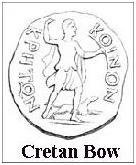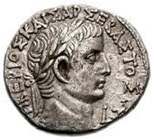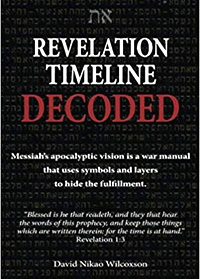The First Seal Of Revelation 6
This Revelation Timeline Decoded Bible study focuses on the first seal of Revelation 6.
Revelation 1:2 reads, “and I saw, and lo, a white horse, and he who is sitting upon it is having a bow, and there was given to him a crown, and he went forth overcoming, and that he may overcome.”
Here’s a short summary of the fulfillment of the 1st seal of Revelation 6, then a video will give more details, followed by a verse by verse written explanation.
The white horse represents the conquering Roman Empire, from 96 – 180 A.D., as it was a time of its greatest expansion and their military conquests were celebrated by riding white horses in their victory parades. Cretan Roman Emperors Trajan, Hadrian, Antoninus Pius and Marcus Aurelius, each had a bow as their symbol. The crown represents the laurel wreathes of victory that were worn by the Caesars after their armies had won a military battle.
Opening First Seal – White Rider Horse of Apocalypse, The 1st Seal of Revelation 6
The first seal is in Revelation 6:2, “And I looked, and behold, a white horse. He who sat on it had a bow; and a crown was given to him, and he went out conquering and to conquer.”
The white horse in Revelation 19 represents Jesus coming in victory to conquer His enemies.
And the image of the white horse in Seal 1 also represents one who will conquer victoriously, the Roman Empire.
John was given the Revelation in 96 A.D., and in Revelation 1:1 Jesus told him that these things would take place shortly.
The Roman Empire fulfilled the first seal from 96 – 180 A.D., as it was a time of the Roman Empire’s greatest expansion and their military conquests were celebrated by riding white horses in their victory parades.
Their conquests expanded the Roman Empire until it occupied much of the territories of the three preceding empires of Babylon, Medo-Persia and Greece.
The bow relates to the Cretan Dynasty of Nerva, as Cretan warriors were known as the most famous race of bowmen in the ancient world.
Alexander the Great was never without a large company of Cretan archers and they were used by Roman armies during the time of Julius Caesar.
At the death of Emperor Domitian, the Roman Senate appointed an elder statesman named Nerva in his place, who was a colonist from the Island of Crete.

He was the first to occupy the Throne of Augustus who was not of Roman descent. He was selected on the merit of his ability.
Known as the “adoptive” emperors, the Nerva–Antonine dynasty consisted of seven Roman Emperors who ruled over the Roman Empire from 96 to 192. A.D.
Roman Emperors Trajan, Hadrian, Antoninus Pius and Marcus Aurelius, each had a bow as their symbol.
The great general Trajan followed Nerva and not only re-established Rome as a conquering force, but established his greatness among scholars as perhaps second only to Augustus.
Marcus Aurelius (as well as the sometimes forgotten Lucius Verus) continued that pattern while re-establishing military superiority among the bordering Germanic tribes.
.
 The crown represents the laurel wreathes of victory that were worn by the Caesars after their armies had won a military battle.
The crown represents the laurel wreathes of victory that were worn by the Caesars after their armies had won a military battle.
Roman emperor Marcus Aurelius had a coin struck that had him wearing his laurel crown on one side and on the back had him going forth and conquering.
The Cretan period was a time of conquest, when they were at the height of their power and prestige, so the white horse was going out conquering and to conquer.
Edward Gibbon, the 18th century historian who penned ‘Decline and Fall of the Roman Empire’, describes 2nd century Rome as perhaps the greatest time of all for humanity.
“In the second century of the Christian Era, the empire of Rome comprehended the fairest part of the earth, and the most civilized portion of mankind.
If a man were called to fix the period in the history of the world, during which the condition of the human race was most happy and prosperous, he would, without hesitation, name that which elapsed from the death of Domitian to the accession of Commodus. The vast extent of the Roman empire was governed by absolute power, under the guidance of virtue and wisdom.”
The period would come to an end amidst plague and the weariness of war with the death of Aurelius in AD 180. As his son Commodus ascended the throne as sole emperor, thus ending the period of ‘adoptive’ authority, the stability and cohesiveness of the previous era would begin to unravel.
During this same time Christ setup His kingdom, fulfilling Daniel 2, so He in effect began to conquer the nations with His Gospel.
Bible scholar and historian Henry Grattan Guinness says that the Early Church interpreted the first vision, that of the crowned rider seated upon the white horse, armed with a bow, going forth “conquering and the conquer,” as a representation of Christ going forth on His victorious mission.
Daniel 2:44 foretold that Christ would setup His kingdom in the days of the four beast. “And in the days of these kings the God of heaven will set up a kingdom which shall never be destroyed; and the kingdom shall not be left to other people; it shall break in pieces and consume all these kingdoms, and it shall stand forever.”
The fact that Christ had founded a Kingdom whose power was greater even than that of Rome, become early apparent. The kingdom of Christ expanded rapidly, by supernatural power, during the first few centuries; while Christ caused the Roman Empire to collapse.
Christ has empowered His Church with the Word of God, the rod of iron, to take control of the nations. Henry Grattan Guinness says;
“And in the vision thus interpreted is found a key to the entire prophecy; for this is the starting point of the whole. Seals, trumpets and vials set forth a continuous course of history stretching to the consummation, having as its commencement the going forth of the Gospel of Christ to accomplish its world-subduing work.
The inference is unavoidable that the Apocalypse presents a prophetic foreview of the entire course of Christian history, from the foundation of the Church to the end of the world. Nor was any other interpretation ever known in the Christian world till the rise of modern futurism.”
Matthew Poole’s Commentary on the Holy Bible, written in the 17th century says;
Some, by this white horse, understand the gospel; others, the Roman empire. And by him that sat thereon with a bow, some understand Christ going forth with power to convert the nations; others (and in my opinion more probably) the Roman emperors, armed with power, and having the imperial crown, carrying all before them. So as that which God intended by this to reveal to St. John, was, that the Roman emperors should yet continue, and use their power against his church.
Those that understand by the white horse, the gospel, or God’s dispensations to his church under the first period, and by the rider, Christ, (amongst whom is our famous Mede), think, that hereby all the time is signified from Christ’s ascension, which was in the thirty-fourth year after his incarnation, till the time that all the apostles were dead, that is, the first hundred years after Christ (for so long histories tell us John lived).
It was the age then current, and so may take up part of the vision of things that were to come. The history of all but forty of those years we have in the Acts, till Paul was carried prisoner to Rome. In this period ruled Augustus Caesar, (in whose time Christ was born, Lu 2:1), Tiberius, Claudius, and Nero, Galba, Otho, F. Vespasianus, Titus, and Domitian, Nerva, and Trajan, ten or eleven in all.
They went on conquering, and to conquer the world. But till Nero’s time, about the year 66, they did not begin to persecute the Christians; nor did Vespasian and Titus much rage, nor Domitian, till he had reigned eight years: so as I leave it indifferent to the reader, whether to understand by the white horse and his rider, God’s dispensations of providence to his church these first years, causing his gospel to prevail much, and conquering many to the profession of it, or the Roman empire, with those that ruled it: what is said is true of both.
John Wesley’s Notes on the Bible, written in the 18th century, says;
And I saw, and behold a white horse, and he that sat on him had a bow – This colour, and the bow shooting arrows afar off, betoken victory, triumph, prosperity, enlargement of empire, and dominion over many people.
Another horseman, indeed, and of quite another kind, appears on a white horse, chap. xix, 11. But he that is spoken of under the first seal must be so understood as to bear a proportion to the horsemen in the second, third, and fourth seal.
Nerva succeeded the emperor Domitian at the very time when the Revelation was written, in the year of our Lord 96. He reigned scarce a year alone; and three months before his death he named Trajan for his colleague and successor, and died in the year 98.
Trajan’s accession to the empire seems to be the dawning of the seven seals. And a crown was given him – This, considering his descent, Trajan could have no hope of attaining. But God gave it him by the hand of Nerva; and then the east soon felt his power.
And he went forth conquering and to conquer – That is, from one victory to another. In the year 108 the already victorious Trajan went forth toward the east, to conquer not only Armenia, Assyria, and Mesopotamia, but also the countries beyond the Tigris, carrying the bounds of the Roman empire to a far greater extent than ever.
We find no emperor like him for making conquests. He aimed at nothing else; he lived only to conquer. Meantime, in him was eminently fulfilled what had been prophesied of the fourth empire, Da 2:40, vii, 23, that he should “devour, tread down, and break in pieces the whole earth.”
John Gill’s Exposition of the Entire Bible, written in the 18th century, says;
And I saw, and behold a white horse, Representing the ministration of the Gospel in the times of the apostles, which were just now finishing, John being the last of them, who saw this vision; and the “horse” being a swift, majestic, and warlike creature, and fearless of opposition and war, may design the swift progress of the Gospel in the world, the majesty, power, and authority with which it came, and opposition it met with, and which was bore down before it;
and its “white” colour may denote the purity of Gospel truths, the peace it proclaims, the joy brings, and the triumph that attends it, on account of victories obtained by it, and which is afterwards suggested: white horses were used in triumphs, in token of victory; a white horse, in a dream, is a good sign with the Jews; and Astrampsychus says, a vision of white horses is an apparition of angels; and so one of those angels which the Jews suppose to have the care of men, and the preservation of them, is said to ride by him, and at his right hand, upon a white horse; but the rider here is not an angel, but the head of all principality and power:
and he that sat on him had a bow; with arrows; the bow is the word of the Gospel, and the arrows the doctrines of it; see Hab 3:9; so called for their swift motion, sudden and secret striking, piercing, and penetrating nature, reaching to the very hearts of men; laying open the secret thoughts and iniquity thereof; wounding, and causing them to fall, and submit themselves to the sceptre of Christ’s kingdom:
and a crown was given unto him; by God the Father; expressive of Christ’s regal power and authority, of his honour and dignity, and of his victories and conquests:
and he went forth, conquering and to conquer; in the ministration of the Gospel, which went forth, as did all the first ministers of it, from Jerusalem, to the several parts of the world; from the east, on which side of the throne was the first living creature, who called upon John to come and see this sight, as the standard of the tribe of Judah, which had a lion upon it, was on the east side of the camp of Israel;
and out of Zion went forth the word of the Lord, which was very victorious, both among Jews and Gentiles, to the conversion of thousands of them, and to the planting of a multitude of churches among them, and to the setting up and advancing the kingdom of Christ; but inasmuch as yet all things are not made subject to him, he is represented as going forth in the Gospel, still conquering, and to conquer, what remain to be conquered: that Christ is designed by him that sat on the white horse, and is thus described, is evident from Re 19:11;
with which compare Ps 45:3, though as this emblem may respect the Roman empire, the white horse may be an emblem of the strong, warlike, and conquering state of it; and the rider which a bow and crown may design Vespasian, whom Christ made use of as an instrument to conquer his enemies the Jews, and who, in consequence thereof, had the imperial crown put upon him; and it may be further observed, that though his conquest of them was a very great one, yet they afterwards rose up in the empire, in great numbers, rebelled, and did much mischief, when they were entirely conquered by Trajan and Hadrian, who seem to be intended in the next seal.
Adam Clarke’s Commentary on the Bible from the early 19th century explains;
A white horse – Supposed to represent the Gospel system, and pointing out its excellence, swiftness, and purity.
He that sat on him – Supposed to represent Jesus Christ.
A bow – The preaching of the Gospel, darting conviction into the hearts of sinners.
A crown – The emblem of the kingdom which Christ is to establish on earth.
Conquering, and to conquer – Overcoming and confounding the Jews first, and then the Gentiles; spreading more and more the doctrine and influence of the cross over the face of the earth.
You can clearly see that the 1st Seal of Revelation has been fulfilled by the Roman Empire and/or by Christ establishing His kingdom, so it does not apply to the end times. This is proven as the other seals caused the downfall of the Roman Empire, as part of Christ’s judgment on them for being pagan and for killing His followers.
Next Revelation Timeline Decoded Bible Study: Revelation 6 – 2nd Seal Red Horse




{ 0 comments… add one now }